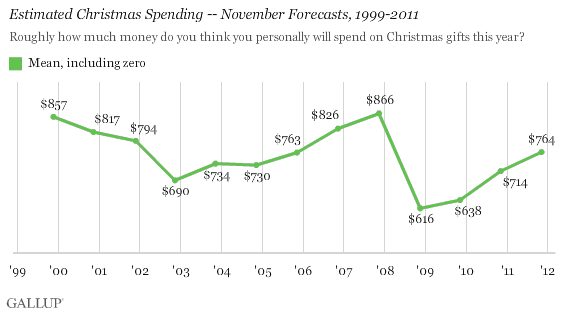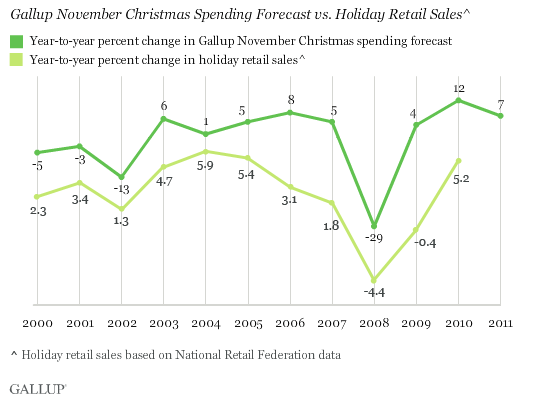PRINCETON, NJ -- Americans currently estimate they will spend an average of $764 on Christmas gifts this year -- $50 more than the $714 they estimated at this time last year, and more than $100 above the depressed levels they forecast in November 2008 and 2009.

The new estimate is based on a Gallup survey conducted Nov. 3-6, 2011. A month ago, Gallup found Americans saying they would spend an average of $712 on gifts this season.
Holiday Spending Intentions Relate to Retail Sales
The 7% increase in Americans' 2011 November Christmas spending forecast compared with last year's -- from $714 to $764 -- points to a modest increase in 2011 holiday retail sales, perhaps on the order of 3% to 4%.
The historical relationship between Gallup's Christmas spending estimate and actual holiday retail sales (as calculated by the National Retail Federation) is not precise. Still, over the past decade, annual changes in Gallup's November forecast have largely paralleled changes in holiday sales.
- In years when Americans' Christmas spending forecast was lower than the previous year's forecast (as in 2000, 2001, and 2002), holiday retail sales typically grew at relatively weak rates (of less than 4%).
- Gallup's unprecedented 29% year-over-year decrease in projected spending in 2008 coincided with a rarely seen 4.4% decline in holiday sales that year.
- In 2009, when consumers' estimated Christmas spending was up slightly but at a low level ($638), the annual change in holiday sales was accordingly low -- in fact, slightly negative -- at -0.4%.
- By contrast, in years when consumers' projected holiday spending was either flat or up slightly at moderately high levels (in 2003, 2004, and 2005), actual retail sales growth was fairly strong, ranging from 4.7% to 5.9%.
- In November 2010, Americans' spending intentions remained relatively weak (at $714) but were up 12% over November 2009. Actual retail sales increased that year by a healthy 5.2%.
- 2006 and 2007 were exception years when Gallup showed moderate increases in consumers' Christmas spending intentions, but sales growth was lackluster.

Implications
Americans have marginally greater Christmas gift-buying intentions today than they did a month ago and a year ago, with the November 2011 figure pointing to a 3% to 4% increase in holiday retail sales over last year. The caveat accompanying this projection is that consumers' psychology -- as is evident in Gallup's Economic Confidence Index -- is extremely fragile, making their willingness to spend partially susceptible to unemployment reports, gyrations on Wall Street, and news about the government's fiscal health. Economic confidence has improved slightly over the past few months, averaging -43 in the past week, versus -54 in late August. However, it remains much worse than a year ago, when it averaged -26.
Survey Methods
Results for this Gallup poll are based on telephone interviews conducted Nov. 3-6, 2011, with a random sample of 1,012 adults, aged 18 and older, living in all 50 U.S. states and the District of Columbia.
For results based on the total sample of national adults, one can say with 95% confidence that the maximum margin of sampling error is ±4 percentage points.
Interviews are conducted with respondents on landline telephones and cellular phones, with interviews conducted in Spanish for respondents who are primarily Spanish-speaking. Each sample includes a minimum quota of 400 cell phone respondents and 600 landline respondents per 1,000 national adults, with additional minimum quotas among landline respondents by region. Landline telephone numbers are chosen at random among listed telephone numbers. Cell phone numbers are selected using random-digit-dial methods. Landline respondents are chosen at random within each household on the basis of which member had the most recent birthday.
Samples are weighted by gender, age, race, Hispanic ethnicity, education, region, adults in the household, and phone status (cell phone only/landline only/both, cell phone mostly, and having an unlisted landline number). Demographic weighting targets are based on the March 2010 Current Population Survey figures for the aged 18 and older non-institutionalized population living in U.S. telephone households. All reported margins of sampling error include the computed design effects for weighting and sample design.
In addition to sampling error, question wording and practical difficulties in conducting surveys can introduce error or bias into the findings of public opinion polls.
View methodology, full question results, and trend data.
For more details on Gallup's polling methodology, visit www.gallup.com.
